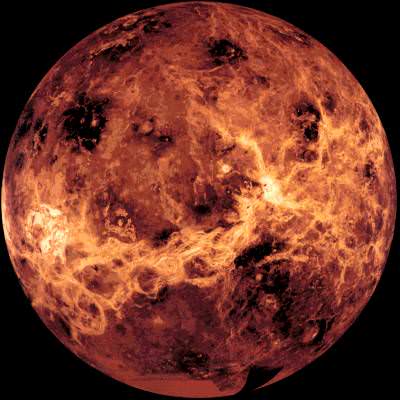It’s time once again for another Where In The Universe Challenge. Test your visual knowledge of the cosmos by naming where in the Universe this image was taken and give yourself extra points if you can name the spacecraft responsible for this picture. Post your guesses in the comments section, and check back later at this same post to find the answer. To make this challenge fun for everyone, please don’t include links or extensive explanations with your answer. Good luck!
UPDATE: The answer has been posted below.
This is a radar image of Venus, taken by the Magellan spacecraft. The radar is able to peer through the murky clouds on Venus to show the surface, so as SteveZodiac said, Venus does look a little naked in this image!
Magellan plunged into Venus’ atmosphere in 1994, never to be heard from again, but for more images and information about the mission, check out the Magellan website.


Venus, RADAR image from the Magellan spacecraft?
Semi-easy.
This is a radar image of the surface of Venus. That’s the easy part. The hard part is the spacecraft.
I’d venture a guess that it’s a mosaic made with data collected by Magellan. Perhaps.
Dang late again, and this was easy. It is a radar map of Venus by Magellan.
LC
That’s a radar image from Venus, though I forget the name of the space craft. Magellan, perhaps?
Thats and old map of venus!
Radar map of the surface of Venus taken by Magellan.
From my first sight i though it was our Sun haha!
Don’t feel bad when/if we’re both wrong. MY first thought was dear old Io. (Galileo might have told me “Tsk, tsk!”
Very unfortunate I had to see all these answers before getting to write mine, even though I was wrong. I too was thinking IO by Galileo…..But yes a radar image of venus by Magellan.
It is obviously Venus on one of those rare Venusian days when all the clouds disappear.
Ooh! she’s naked
I’m very surprised to see this stump up a few people. 🙂 I always thought the missing data is nicely hidden also in this image.
Venus/Radar/Magellan probe
Looks like Venus. But i think it is an artists representation of Earth a few million years after the radiation device was set off in the Asimov Foundation Series.
Venus
Computer-generated global view centered at 180° E. longitude
from Magellan (mostly) with some data gaps filled from Pioneer-Venus Orbiter data.
Now to read the other comments and see that everyone already knew that?
I think PolishBear wins this one. =D